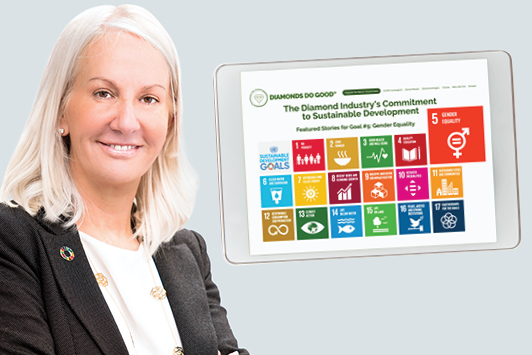
Over the last 15 years, the Responsible Jewellery Council (RJC) has been setting the tone for ethical business practices. It has grown from its original 14 members to 1,300, 60% of which are small enterprises. Spanning over 70 countries, it has established a global community of leaders in the responsible-business field, and in December 2020, it announced that it was working on a 10-year plan — the “Roadmap to 2030 and Beyond” — to achieve the UN’s 17 sustainable development goals (SDGs).
“Consumers are seeking brands...that go beyond simply meeting legislative requirements and ensure they bring their products to the market in a responsible way — and also generate a long-term positive impact as they do that,” says RJC executive director Iris Van der Veken. “Consumers appreciate the brands that take care of their supply chain, their employees, the environment, and also the communities around them.” Here, she outlines ways that companies committed to sustainability can improve their policies.
How can smaller-scale members implement key SDGs in their everyday practices? The RJC can support this process. We frequently host webinars and training sessions for members, to educate and guide them on their journey of integrating responsible business practices and the SDGs right at the core of their business strategy, no matter their size. Our 2030 roadmap provides sustainable and responsible pathways for our members to contribute to long-term impacts and the SDGs.
Ultimately, the SDGs are a framework, a guidance. Each company needs to see the SDGs through the lens of its own business and decide which SDGs are most relevant to them. For example, there are actions available to all companies around gender empowerment — SDG number five. Likewise, looking after your employees relates to SDG number eight — sustainable work. SDG 12 is about responsible consumption relating to supply chains, how materials are sourced and produced. Again, smaller companies can have an impact on their suppliers. These are all practical initiatives available to any organization, and if we all take that approach, that is how the 2030 agenda will be won.
Sustainability begins with decent practices in your own operations — looking at labor practices, product integrity and accurate disclosure. The more a business understands its supply chain, the more it can ensure that its products are produced responsibly and in a way that respects the rights of workers, communities and the environment. It is all about your company having a positive impact on the livelihoods of people and communities.
One of the key campaigns, Generation Equality, is dedicated to women in the industry. How does it fit into the overall sustainability agenda? The empowerment of women is at the very heart of the whole sustainability agenda. It is abhorrent that women are still marginalized and oppressed in so many countries and regions. There are literally millions of women in the jewelry industry, in all sectors — mining, cutting and polishing, manufacturing and retail. So our industry has a particular responsibility to take real action to uplift those women where it can. The artisanal and small-scale mining (ASM) sector is especially relevant here. Proper, meaningful due diligence is the best tool to reveal the issues.
In 2020, the RJC advanced its agenda on SDG five and gender equality, a topic which is very close to my heart. Gender equality is presented as a necessary milestone to achieving all SDGs; it is considered a multiplier. We should not forget in our industry that women drive 90% of jewelry demand globally. The reality is that we are not doing enough. In fact, according to the World Economic Forum’s 2020 Global Gender Gap Report, it will take 257 years to close the economic gender gap. Historically, women are especially vulnerable during crises, and Covid-19 is no different. Already, domestic violence and child marriage are on the rise. With schools and childcare services closed, women and girls are taking on most household and caregiving responsibilities.
For a small to mid-size company, how can a sustainable overhaul improve business? Simply by looking seriously at your supply chain, at how you understand it and how you can impact it. Also by understanding the immediate impacts of your own business — and where you take actions like reducing energy use, [using] recycled packaging and the like.
There are different responsibilities that must be demanded, governed, and complied with by traders, suppliers, designers, manufacturers, logistics providers, buyers, retailers, investors, employees, and ultimately the consumer, who [chooses] from which company to buy. In order for a business to be truly sustainable, there are some values that are, or should be, entirely non-negotiable. These include a commitment to human rights, fair and environmentally friendly sourcing practices, transparency across the various components, and a set of strong leadership business values.
The need for factoring in the true cost of doing business is now paramount; in other words, we can no longer ignore the cost to the planet. Research shows that companies that integrate environmental, social and corporate governance into their business practices become more resilient.
What do you see as the biggest challenge to improving the supply chain as a whole?
From our industry’s perspective, ASM needs our urgent attention. The ASM sector can have many positive impacts: rural employment opportunities, income for women who work as miners or in the surrounding mining communities, as well as mining being an economic activity that supports millions of families.
Indeed, approximately 85% of colored gemstones come from ASM, which has a complex, fragmented supply chain. It is very encouraging to see that a growing number of players are adopting and promoting responsible practices. We should keep in mind that this is a step-by-step approach based on continuous improvement, and we are confident that positive changes are on the way.
Article from the Rapaport Magazine - April 2021. To subscribe click here.